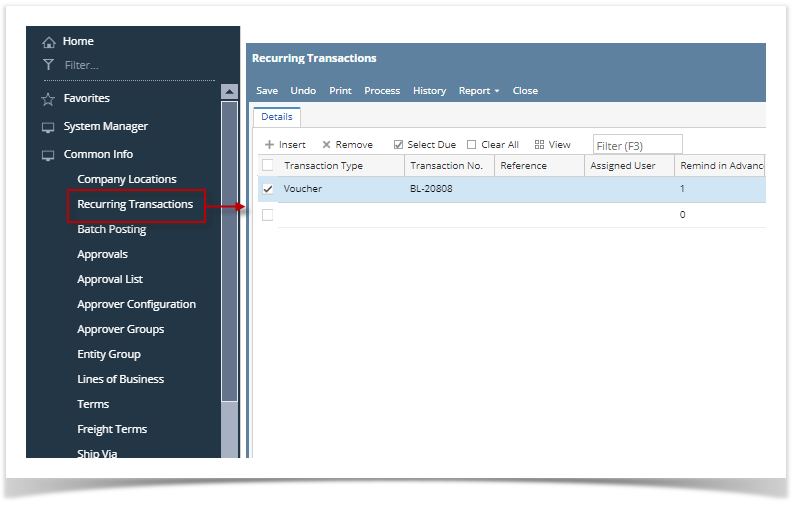After a voucher for recurring was created (see How To Create Vouchers for Recurring), it will be available to be selected in Recurring Transaction screen. There are two ways to open this screen:
- Via Common Info > Recurring Transactions

- Via Purchasing (A/P) > Voucher screen > Recurring button

Here are the steps on how to create new Recurring Transaction:
...
| Expand |
|---|
|
After a voucher for recurring was created (see How To Create Vouchers for Recurring), it will be available to be selected in Recurring Transaction screen. There are two ways to open this screen: - Via Common Info > Recurring Transactions
 - Via Purchasing (Accounts Payable) > Voucher screen > Recurring button

Here are the steps on how to create new Recurring Transaction: - From the Recurring Transactions screen, select 'Voucher' Transaction Type.
- Click the Transaction No. combo box button and select from the list the voucher for recurring.
- Enter any reference you want to make to the recurring transaction in the Reference field if necessary.
- Select Assigned User.
- Enter number of days when the reminder will be displayed in advance in Remind in Advance field.
The Frequency field is where you set how often a transaction recurs. By default, it is set to Monthly. In case you want to change the setup, click the Frequency combo box button and select a different frequency from the list. Frequency occurrences in a year is as follows: - Daily = 365
- Weekly = 52
- Bi-Weekly = 26
- Semi-Monthly = 24
- Monthly = 12
- Bi-Monthly = 6
- Quarterly = 4
- Semi-Annually = 2
- Annually = 1
- The Last Process field will automatically be filled in with today's date. Every time you process the selected transaction the Last Process date will be updated with that date.
- The Next Process field will automatically be filled based on the Frequency entered. This can be changed to whatever date you want the transaction to recur again.
- The Due field will show whether the transaction is due to be processed or not. It is the Next Due date that is used as the basis whether the transaction becomes due. If the Next Process date is later than the Business Date, then this field will show as Yes however if it is a date before the Business Date, then it will show as No.
- The Day of Month will be defaulted to the day based on the date of creation of the original transaction. To change, click Day of Month combo box button and select different day from the list.
- The Start Date by default will show the same date shown in the Next Process field. You may set this to any date if necessary by entering date manually or by clicking the date picker button and select different date from the mini calendar screen.
- The End Date by default will show the same date shown in the Next Process field. You may set this to any date if necessary by entering date manually or by clicking the date picker button and select different date from the mini calendar screen.
- Check the Active check box to enable transaction from recurring.
- The Iterations by default will show 1. This is used to display how may times the transaction is to be recurred. Changing the number of this field will simultaneously change the End Date.
- Click Save button to save Recurring Transaction record.
|
...



